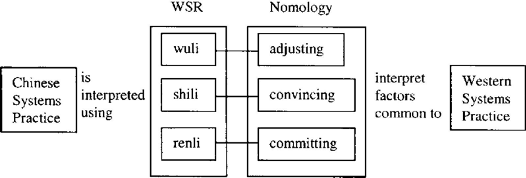WSR, Wuli, Shili, Renli
Adapted from the article originally written by Kate Long
for the Cabrera's Cornell University, System Thinking in Public Affairs Course
SUMMARY
Wuli-Shili-Renli (WSR) was born in 1995 at a conference by the Centre for Systems Studies at the University of Hull (UK) through joint research by the Japanese Konan University and the Chinese Science Academy.[1] The method was compiled from research stemming from China in the 1950s, throughout the 1970s.[1]
The method states that the regularities in the objective world (the wuli), the ways of seeing and doing (the shili), and the patterns in human relations (the renli) are parts of a whole that should be looked at holistically and systematically when designing methods to manage knowledge.[1] Because WSR was developed within a Chinese context, it is distinctly framed by the philosophical, cultural, social, political, and economic spheres of that context.[1]
WU: OBJECTIVE EXISTANCE
SHI: SUBJECTIVE MODELING
REN: INTERSUBJECTIVE HUMAN RELATIONS
CORE PRINCIPLES
The principle of wuli focuses on “observing, analyzing and obtaining knowledge” through asking what constitutes the natural world, and confronting our life concerning systems.1 Shili emphasizes investigating and understanding how the world can better be modeled and managed by creating definitions for a specific system, while reflecting on our assumptions of the complexity of systems.1 The third stage, renli, is for generating synergies and overcoming obstructive factors, ensuring that the system best serves humans’ needs and interests.1 While all components of WSR should be considered, one may become more crucial at different periods during the systems design. However, all elements are essential, and one cannot be ignored in favor of another.[1] The interconnectedness of the wuli, shili, and renli shape our knowledge about the how the world works, what to do, and how to act.[1]

In considering a community revitalization project, the principles of WSR can be used according to the model above (figure 1). Wuli would tell us about the economy and society, as well as possible funds, and clarify the purpose and revise the goals. Possible ways to realize the goal would appear in shili, along with reviewing and adjusting the methods and means to complete the project. The preferences and cooperation of the residents, and evaluation of the implementation would be analyzed in renli, and if necessary, the process can re-start.

Western approaches to Systems Thinking are more rules-focused but allow for more creativity. The WSR approach puts an emphasis on collective interests above personal interests and sees “the big picture,” while western approaches are more individualistic. More Western systems thinking processes are model orientated; the WSR process is more goal-oriented and must find a solution to satisfy the most stakeholders.
Through these comparisons, WSR can be used as a bridge to help Chinese Systems researchers understand Western systems ideas, and vice versa.[4]
DISCUSSION
|
STRENGTHS |
WEAKNESSES |
|
Accessible to Western thinkers [3] |
Requires common logic from general problem-solving (GPS) [5] |
|
Flexibility [1] |
Allows for less creativity [4] |
|
Sees “the big picture” [4] |
Requires formal, specific model and facilitation skills for understanding [6] |
It is important to point out that because WSR suffers from these weaknesses, it may be useful to utilize a more systematic, formalized, and specific, systems thinking model such as DSRP along with WSR in order to make it more manifest in its problem-solving.
SOURCES & FURTHER READING
- Gu, J., & Zhu, Z. (2000). Knowing Wuli, Sensing Shili, Caring for Renli: Methodology of the WSR Approach. Systemic Practice and Action Research, 13(1), 11-20.
- Pan, X., Valerdi, R., & Kang, R. (2013). Systems Thinking: A comparison between Chinese and Western Approaches. Procedia Computer Science, 1027-1035.
- Nakamori, Y. (2013). Knowledge and Systems Science: Enabling Systemic Knowledge Synthesis.
- CRC Press.
- Brugha, C. M. (2001). Systemic Thinking in China: A Meta-Decision-Making Bridge to Western Concepts. Systemic Practice and Action Research, 14(3), 339 - 360.
- Zhu, Z. (2000). WSR: A Systems Approach for Information Systems Development. Systems Research and Behavioral Science, 17, 183 - 203.
- Midgley, G., Gu, J. & Campbell, D. (2000). Dealing with Human Relations in Chinese Systems Practice. Systemic Practice and Action Research 13(1), 71-96.
- Cabrera, D. and Cabrera, L.. (2017). Systems Thinking Made Simple. Odyssean Press. Ithaca, NY..
